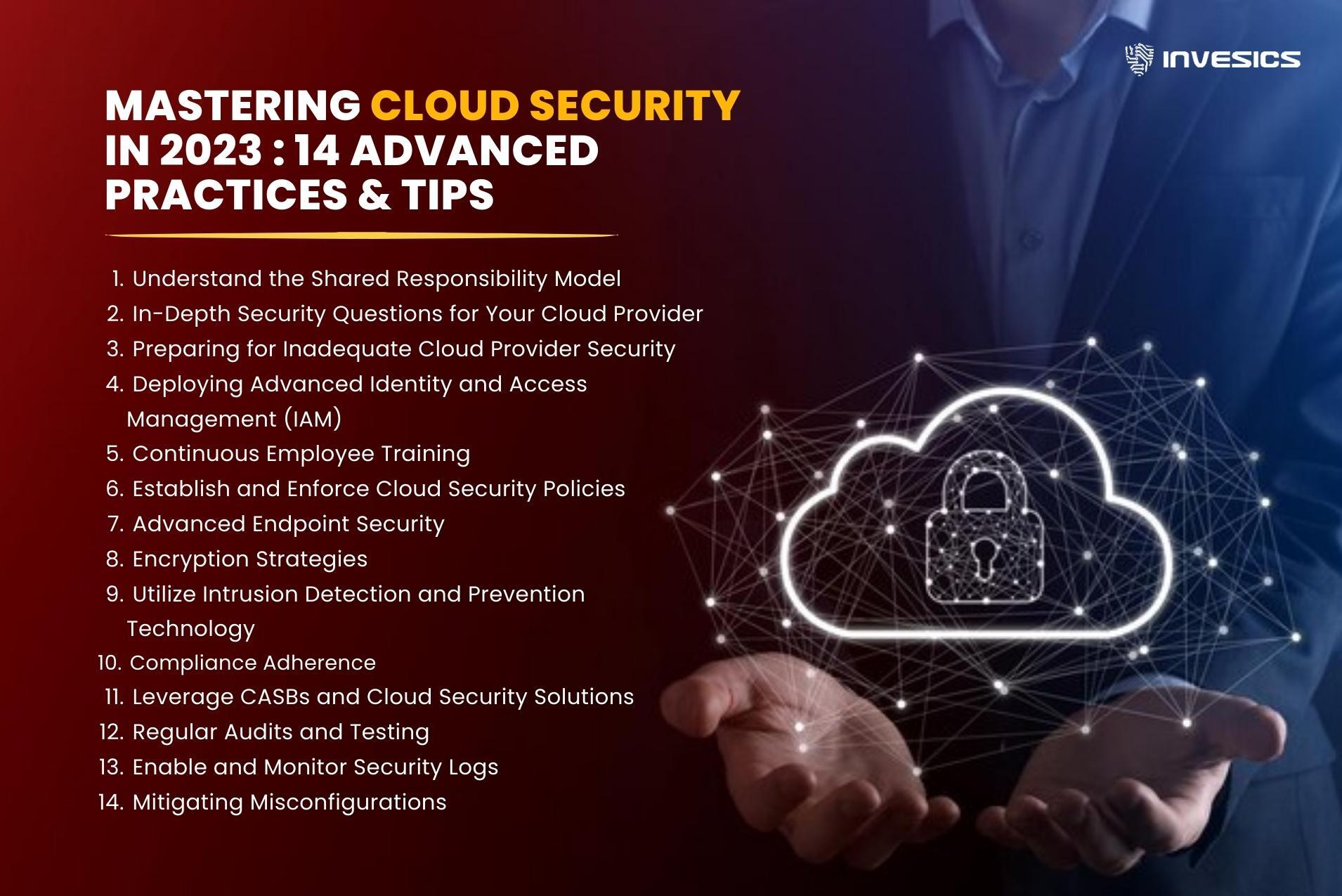Mastering Cloud Security in 2023: 14 Advanced Practices & Tips
Overview
In the ever-evolving realm of cloud computing, security is a relentless pursuit for organizations in 2023. While the cloud offers unparalleled scalability and flexibility, it also introduces a complex landscape of shared responsibilities and evolving threats. In this advanced guide, we will delve deep into 14 cloud security best practices and tips that go beyond the basics, equipping you with the knowledge to fortify your cloud infrastructure.
Cloud security starts with understanding the shared responsibility model. While cloud providers like AWS and Microsoft Azure shoulder some security responsibilities, it’s essential to recognize that the ultimate onus lies with the cloud customer. Dive into provider-specific documentation to comprehend your role in different deployment scenarios, ensuring no gaps in security controls.
2. In-Depth Security Questions for Your Cloud Provider:
Don’t assume that leading cloud vendors have security covered. Probe your cloud provider with detailed questions, such as server locations, incident response protocols, disaster recovery plans, access protection mechanisms, technical support levels, penetration test results, data encryption practices, role-based data access, authentication methods, supported compliance requirements, and more. Thorough due diligence minimizes surprises and ensures alignment with your security needs.
3. Preparing for Inadequate Cloud Provider Security:
In a worst-case scenario where your cloud provider falls short in security measures, your business could face grave risks. Data breaches, downtime, compliance violations, and delayed threat detection are just a few consequences. To mitigate such risks:
- Scrutinize your cloud provider’s security capabilities, potentially involving third-party security specialists.
- Review service-level agreements (SLAs) to specify security provisions clearly.
- Enhance your security procedures with encryption, access controls, and monitoring.
- Implement cross-cloud data backups to mitigate downtime and data loss risks.
- Explore alternative cloud providers that align better with your security and compliance requirements.
4. Deploying Advanced Identity and Access Management (IAM):
Unauthorized access remains a significant concern in cloud security. Implement IAM systems based on the principles of least privilege and zero trust. Enforce access controls that grant permissions via role-based access control (RBAC). Elevate security with multi-factor authentication (MFA), which adds an additional layer of protection even if credentials are compromised. Look for IAM solutions that span private data centers and cloud deployments for seamless policy enforcement.
5. Continuous Employee Training:
Educating your workforce is paramount in preventing breaches. Offer comprehensive cybersecurity awareness training to equip employees with skills to identify threats, create strong passwords, detect social engineering attacks, and understand advanced concepts like risk management. Stress the risks of shadow IT and provide specialized training for security personnel to stay ahead of emerging threats.
6. Establish and Enforce Cloud Security Policies:
Craft comprehensive guidelines that define who can use cloud services, how they can use them, and which data can be stored. Specify mandatory security technologies to protect data and applications. Enforce policy adherence to safeguard your cloud environment effectively.
7. Advanced Endpoint Security:
Cloud adoption intensifies the need for robust endpoint security. Implement a defense-in-depth strategy involving firewalls, anti-malware, intrusion detection, access control, patch management, endpoint encryption, VPNs, and insider threat prevention. Endpoint detection and response (EDR) tools, endpoint protection platforms (EPP), and additional controls such as VPNs further enhance security.
8. Encryption Strategies:
Encryption forms the backbone of cloud security. Encrypt data both in transit and at rest. Seek seamless encryption solutions that align with existing workflows, eliminating end-user complexities. Explore encryption services offered by cloud providers or third-party vendors to protect data integrity and confidentiality.
9. Utilize Intrusion Detection and Prevention Technology:
Intrusion detection and prevention systems (IDPS) play a pivotal role in safeguarding your cloud environment. These systems monitor, analyze, and respond to network traffic, identifying potential threats in real-time. Major cloud providers offer IDPS and firewall services, while third-party cybersecurity companies provide additional options to fortify your cloud security posture.
10. Compliance Adherence:
For organizations handling sensitive data, compliance with regulations like GDPR, HIPAA, or industry-specific standards is non-negotiable. Conduct thorough compliance reviews to ensure your cloud provider aligns with your specific data security needs. Any regulatory breaches, even if stemming from the cloud provider, hold your business accountable.
11. Leverage CASBs and Cloud Security Solutions:
Consider Cloud Access Security Brokers (CASBs) to enforce cloud security standards across multiple providers and track unauthorized app activity. These solutions encompass data loss prevention, malware detection, compliance assistance, and shadow IT control. Evaluate cloud-native application protection (CNAPP), cloud workload protection platforms (CWPP), and cloud security posture management (CSPM) tools based on your unique requirements.
12. Regular Audits and Testing:
Penetration tests, vulnerability scans, and security audits are indispensable. Engage in proactive security practices, including penetration testing to identify vulnerabilities, vulnerability scans to detect misconfigurations, and regular security audits to assess vendor capabilities and adherence to security standards. Rigorously review access logs to ensure only authorized individuals have access to sensitive data.
13. Enable and Monitor Security Logs:
Enabling comprehensive logging within your cloud services is one of the most potent security measures available. Implement centralized monitoring and response by ingesting logs into a Security Information and Event Management (SIEM) system. Logging not only aids in monitoring user activity but also provides an audit trail for threat detection and prevention.
14. Mitigating Misconfigurations:
Misconfigurations represent a significant threat in the cloud. Actively reduce misconfigurations in storage buckets, APIs, connections, open ports, permissions, and encryption settings. Customize configurations, collaborate with development teams, avoid default access permissions, and enforce strict user access levels.
In the complex and dynamic landscape of cloud security, mastering these advanced practices and tips will empower your organization to navigate the challenges and protect your data and operations effectively in 2023 and beyond.
Achieve cloud-based data protection with Invesics Pentest
At INVESICS, we understand that implementing cloud security best practices is vital in today’s digital landscape. Our team of expert cybersecurity professionals specializes in helping businesses like yours achieve robust cloud-based data protection.
With Invesics Pentest, our cutting-edge penetration testing service, we provide comprehensive assessments of your cloud infrastructure’s security. We identify vulnerabilities, weaknesses, and potential threats, offering actionable insights to strengthen your cloud security posture.
Our services include:
- Cloud Security Audits: Our team conducts thorough security audits to assess your cloud environment’s vulnerabilities and risks.
- Penetration Testing: We simulate real-world attacks to identify and remediate potential weaknesses in your cloud infrastructure.
- Security Awareness Training: We offer training programs to educate your staff on security best practices, reducing the risk of human error.
- Incident Response Planning: We help you develop and test incident response plans to ensure a swift and effective response to security incidents.
Secure your cloud infrastructure and protect your sensitive data with Invesics Pentest. Contact us today to learn more about our tailored solutions and take your cloud security to the next level.


